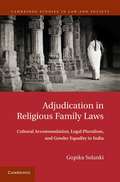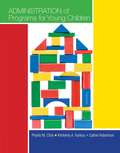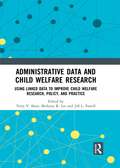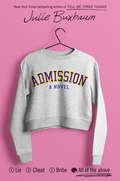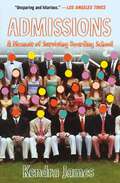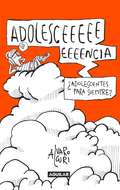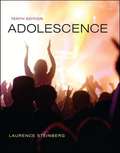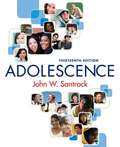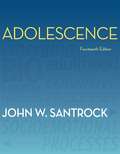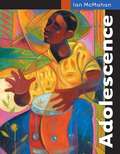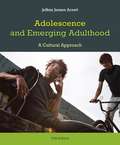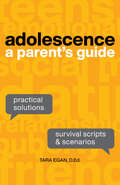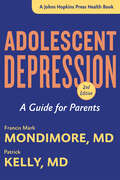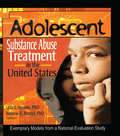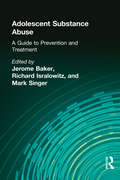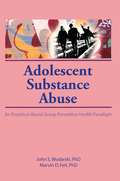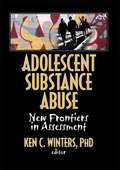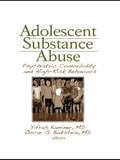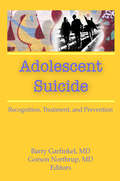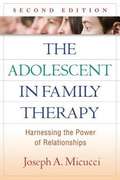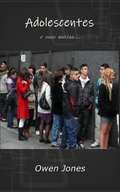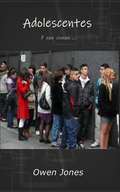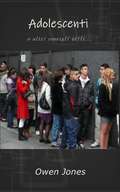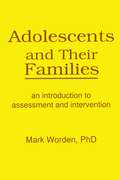- Table View
- List View
Adiós, pequeño
by Janet Ahlberg Allan Ahlbergun niño está triste porque no tiene mamá. Cuando va en busca de una mamá, encuentra amigos y aventuras.
Adjudication in Religious Family Law
by Gopika SolankiThis book argues that the shared adjudication model in which the state splits its adjudicative authority with religious groups and other societal sources in the regulation of marriage can potentially balance cultural rights and gender equality. In this model the civic and religious sources of legal authority construct, transmit and communicate heterogeneous notions of the conjugal family, gender relations and religious membership within the interstices of state and society. In so doing, they fracture the homogenized religious identities grounded in hierarchical gender relations within the conjugal family. The shared adjudication model facilitates diversity as it allows the construction of hybrid religious identities, creates fissures in ossified group boundaries and provides institutional spaces for ongoing intersocietal dialogue. This pluralized legal sphere, governed by ideologically diverse legal actors, can thus increase gender equality and individual and collective legal mobilization by women effects institutional change.
Administration of Programs for Young Children
by Phyllis M. Click Kimberly A. Karkos Cathie RobertsonADMINISTRATION OF PROGRAMS FOR YOUNG CHILDREN is a tried and true guide for early childhood education students who want to be directors, as well as a comprehensive resource for those who are already directors. The text emphasizes the role of leaders/managers and their function in relation to new staff, while simultaneously addressing the needs of children, parents, and other staff. Coverage includes a wide variety of information about relevant program elements as well as methods and principles related to supervising student teachers, assistant teachers, teachers, parents, and volunteers. Real-life scenarios equip working directors with problem- solving techniques; readers also learn best practices in child care program management. Highlights include a fresh new design, a new chapter diversity, up-to-date technology information, and new TeachSource Videos integrated into each chapter.
Administrative Data and Child Welfare Research: Using Linked Data to Improve Child Welfare Research, Policy, and Practice
by Terry V. Shaw, Bethany R. Lee and Jill L. FarrellEvery day, social service agencies collect millions of pieces of data about the children and families they serve. Agencies depend on this data to inform decision-making by personnel throughout the organization and to provide meaningful research and evaluation on program effectiveness and outcomes. As capacity for collecting and utilizing data has increased so has the recognition that this data can and should be used more broadly. Further, it should include not just single-system data, but data across different human service agencies. Administrative/big data systems can be powerful tools in increasing the efficiency and effectiveness of public child welfare services. Understanding, harnessing, and using big data holds tremendous promise in creating transformative change in the social services. Data analytics and data mining can lead to a better understanding of what services work for specific populations (targeting and predictive modelling), provide a more nuanced understanding of service outcomes for the workforce and major stakeholders (transparency), and facilitate collaboration across existing service delivery silos to reduce duplication of services and enhance consumer access to services (efficiency). This book was originally published as a special issue of the Journal of Public Child Welfare.
Admission
by Julie BuxbaumFrom the New York Times bestselling author of Tell Me Three Things comes an of-the-moment novel that peeks inside the private lives of the hypercompetitive and the hyperprivileged and takes on the college admissions bribery scandal that rocked the country.It's good to be Chloe Wynn Berringer. She's headed off to the college of her dreams. She's going to prom with the boy she's had a crush on since middle school. Her best friend always has her back, and her mom, a B-list Hollywood celebrity, may finally be on her way to the B+ list. It's good to be Chloe Wynn Berringer--at least, it was, until the FBI came knocking on her front door, guns at the ready, and her future went up in smoke. Now her mother is under arrest in a massive college admissions bribery scandal. Chloe, too, might be facing charges, and even time behind bars. The public is furious, the press is rabid, and the US attorney is out for blood.As she loses everything she's long taken for granted, Chloe must reckon not only with the truth of what happened, but also with the examination of her own guilt. Why did her parents think the only way for her to succeed was to cheat for her? What did she know, and when did she know it? And perhaps most importantly, what does it mean to be complicit?
Admissions: A Memoir of Surviving Boarding School
by Kendra JamesNAMED A BEST NONFICTION BOOK OF 2022 BY ESQUIRE &“[C]harming and surprising. . . The work of Admissions is laying down, with wit and care, the burden James assumed at 15, that she — or any Black student, or all Black students — would manage the failures of a racially illiterate community. . . The best depiction of elite whiteness I&’ve read.&”—New York Times A Most Anticipated Book by Vogue.com · Parade · Town & Country · Nylon ·New York Post · Lit Hub · BookRiot · Electric Literature · Glamour · Marie Claire · Publishers Weekly · Bustle · Fodor's Travel· Business Insider · Pop Sugar · InsideHook · SheReads Early on in Kendra James&’ professional life, she began to feel like she was selling a lie. As an admissions officer specializing in diversity recruitment for independent prep schools, she persuaded students and families to embark on the same perilous journey she herself had made—to attend cutthroat and largely white schools similar to The Taft School, where she had been the first African-American legacy student only a few years earlier. Her new job forced her to reflect on her own elite education experience, and to realize how disillusioned she had become with America&’s inequitable system. In ADMISSIONS, Kendra looks back at the three years she spent at Taft, chronicling clashes with her lily-white roommate, how she had to unlearn the respectability politics she'd been raised with, and the fall-out from a horrifying article in the student newspaper that accused Black and Latinx students of being responsible for segregation of campus. Through these stories, some troubling, others hilarious, she deconstructs the lies and half-truths she herself would later tell as an admissions professional, in addition to the myths about boarding schools perpetuated by popular culture. With its combination of incisive social critique and uproarious depictions of elite nonsense, ADMISSIONS will resonate with anyone who has ever been The Only One in a room, dealt with racial microaggressions, or even just suffered from an extreme case of homesickness.
Adolesceeeencia: ¿Adolescentes para siempre?
by Alvaro AlcuriEl psicólogo Álvaro Alcuri, con mirada aguda y comunicación clara, reflexiona sobre esta etapa de la vida en este momento sociocul tural en que la adolescentitis, o adolescencia sin fin, nos define. A partir de su experiencia profesional, analiza situaciones co tidianas que atraviesan nuestros adolescentes y que nos interpelan como padres, educadores y ciudadanos. ¿Qué es la adolescencia? ¿Es el despertar biológico de la madurezsexual? ¿Es hormonal? ¿Social? ¿Cultural? ¿Es todo eso junto? ¿Es uninvento de la moder-nidad? El psicólogo Álvaro Alcuri, con mirada aguday comunicación clara, reflexiona sobre esta etapa de la vida en estemomento sociocultural en que la adoles¬centitis, o adolescencia sin fin,nos define. A partir de su experiencia profesional, analiza situacionescotidia¬nas que atraviesan nuestros adolescentes y que nos interpelancomo padres, educadores y ciudadanos.«La adolescencia sin fin de Peter Pan y el País del Nunca Jamás, debe,algún día, terminar. Nosotros, padres, edu¬cadores, figuras de autoridaddebemos comunicárselo a los muchachos, en tiempo y forma, fuerte yclaro. No hay otro camino. Si no "mueren" como adolescentes, nuncanacerán adultos, y sin adultos, estaremos construyendo una sociedadlight, con padres que lloran la milonga y les piden a otros, al PadreEstado, a educadores, mé¬dicos, psicólogos, policías, que solucionen loque ellos no pueden, que eduquen lo que no les resultó cómodo educar,que pongan los límites que no supieron poner.
Adolescence
by Laurence SteinbergIn this tenth edition of Adolescence, Laurence Steinberg continues to utilize an effective combination of a friendly writing style, thorough research, and a contextual approach that emphasizes adolescence in contemporary society. The text's careful organization ensures maximum teaching flexibility that allows the chapters to work together to be covered in sequence or to stand alone. Ethnicity and minority issues are thoroughly discussed in a way that enables students to see how the adolescent experience is shaped by class and culture. The strong pedagogical framework helps students organize and integrate material. Thoroughly updated to reflect current findings in the field of adolescent development, Adolescence is based on solid research and theory, yet it has a distinctively "real world" feel that emphasizes the reality of being an adolescent in today's society.
Adolescence (13th edition)
by John W. SantrockThe new edition includes substantially expanded material on diversity and culture, adolescents and emerging adults health and well-being, including numerous recommendations for improving the lives of adolescents.
Adolescence (Fourteenth Edition)
by John W. SantrockMore students learn from John Santrock’s Adolescence than from any other text in this field. The 14th edition combines proven pedagogy and the most current research to provide a market leading presentation of adolescence. This time tested text provides compelling contemporary research, including updates from eleven leading experts in the field. The text's accessible presentation, plentiful applications and engaging writing foster increased mastery of the content. The new edition includes substantially expanded material on diversity and culture, adolescents’ and emerging adults’ health and well-being, including numerous recommendations for improving the lives of adolescents, and expanded emphasis on the positive aspects of adolescent development.
Adolescence (My Development Kit Series)
by Ian McMahanAdolescence, by Ian McMahan, combines rigorous, scientific coverage of adolescent development research with a scholarly yet enjoyable narrative style that is rarely found in textbooks. <P><P>The table of contents follows an ecological systems framework to show how individual teens both affect and are affected by their families, peers, schools, and society. <P><P>Adolescence also employs unique pedagogy to ensure students practice active learning and deep processing, focus on the practical applications of what they are studying, think critically and become educated consumers of the research
Adolescence and Emerging Adulthood: A Cultural Approach
by Jeffrey Jensen ArnettHelps students understand how culture impacts development in adolescence and emerging adulthood. Grounded in a global cultural perspective (within and outside of the US), this text enriches the discussion with historical context and an interdisciplinary approach, including studies from fields such as anthropology and sociology, in addition to the compelling psychological research on adolescent development. This book also takes into account the period of "emerging adulthood" (ages 18-25), a term coined by the author, and an area of study for which Arnett is a leading expert. Arnett continues the fifth edition with new and updated studies, both U. S. and international.
Adolescence: A Parent's Guide
by Tara Egan D.Ed.Survive adolescence—with the guide no parent should be without Getting through adolescence is tough, but you can help your child make it through—and maintain a strong relationship! Covering everything from late childhood to puberty to emerging adulthood, Adolescence: A Parent's Guide offers you and your child the kind of sound and thoughtful advice you'll wish you'd gotten in your adolescence. Divided into five chapters—each covering a specific age range—this guide digs deep into the most common aspects of adolescence. Whether it's dealing with dishonesty, managing changing relationships, or handling the age-old question of sex, this simple and straightforward guide has your back. You get a toolbox full of effective approaches that are easy to implement and can be tailored to your specific needs. Adolescence: A Parent's Guide includes: Understanding today's adolescents—Refresh your knowledge with the most modern and up-to-date information available. Actionable advice—Discover strategies for overcoming common adolescent hurdles—like when kids start testing limits or stressing out over social media. Talking it out—Sample scripts and scenarios provide helpful guidelines for navigating challenging conversations and situations with your growing child. Make sure the two of you get through adolescence in one piece with this comprehensive book.
Adolescent Depression: A Guide for Parents (A Johns Hopkins Press Health Book)
by Patrick Kelly Francis Mark MondimoreThe timely second edition of this bestselling guide will inform and encourage struggling adolescents and their families.In Adolescent Depression, psychiatrists Francis Mark Mondimore, MD, and Patrick Kelly, MD, explain that serious depression in adolescents goes beyond "moodiness." Depression is in fact an illness—one that can be effectively treated. The authors describe the many forms of depression and the many symptoms of depression in young people—from sadness to irritability, self-harm, drug and alcohol abuse, and violent rages. Incorporating the latest research from the field of adolescent psychiatry, this comprehensive and compassionate guide answers questions that many parents have, including What are the symptoms of depression in teenagers? How is depression diagnosed? What is the difference between depression and bipolar disorder, and which does my child have? How can I find the best mental health professional team for my child? What kinds of counseling and psychotherapy are available? Are medications safe, and how does a doctor choose a medication for my child? What can I do if my adolescent is using alcohol, crystal meth, marijuana, or other substances? How do autism and Asperger's syndrome, eating disorders, premenstrual dysphoric disorder, ADHD, and disruptive mood dysregulation disorder interact with depression? What should I do if I sense that my child is in danger? With all of this going on, how can I take care of myself?
Adolescent Substance Abuse Treatment in the United States: Exemplary Models from a National Evaluation Study
by Andrew R. Morral Bernard Segal Sally J StevensYou don’t have to reinvent the wheel--select and implement an effective substance abuse program from this essential book!This essential book is the first ever published on exemplary models of adolescent drug treatment. It delivers detailed descriptions of exemplary drug treatment models and gives you the latest information on substance use and its consequences to aid your work with adolescents who use alcohol and drugs.The in-depth examinations of treatment models you&’ll find in this book include programs serving adolescent substance users from a wide range of ethnic and cultural backgrounds (African Americans, Hispanics, Whites, Native Americans, Russian Immigrants). With sections covering outpatient, residential, family-oriented, and modified therapeutic community (TC) programs, this book is a vital reference for educators and students as well as practitioners.Adolescent Substance Abuse Treatment in the United States: Exemplary Models from a National Evaluation Study gives you thoughtful examinations of: trends in adolescent substance use and treatment approaches three exemplary outpatient treatment programs, including program design, treatment issues, and client characteristics the Multidimensional Family Therapy Approach (MDFT), a family-oriented outpatient treatment model used to intervene with younger adolescents a 30- to 60-day residential treatment program that is based on a medical model which blends in treatment approaches from the therapeutic community model the special treatment needs and issues of substance-using Native American youths issues of gender differences as they relate to drug use and trauma three different modified therapeutic community treatment models and much more!Adolescent Substance Abuse Treatment in the United States is an invaluable source of information for anyone working with this vulnerable population. Use it to choose and implement the program that will work best for you and your clients!
Adolescent Substance Abuse: A Guide to Prevention and Treatment
by Richard Isralowitz Mark Singer Jerome BekerAn enlightening discussion of the major issues related to the prevention and treatment of adolescent substance abuse. Information-packed chapters lend a new perspective to the field and suggest implications for practice in services for youth.
Adolescent Substance Abuse: An Empirical-Based Group Preventive Health Paradigm
by John S Wodarski Marvin D FeitHere is a comprehensive review of adolescent substance abuse issues and an expansive, empirically based curriculum for school-based programs to teach adolescents about the dangers of drugs and alcohol. The abuse of alcohol and other drugs among young people is a problem of alarming scope and gravity. Adolescent Substance Abuse explores the multiple forces which impact adolescents and can push them toward drug and alcohol abuse.Adolescent Substance Abuse proposes means by which to effect macro-level change in societal norms and values regarding substance abuse. The authors describes in detail an effective means of teaching adolescents about drugs and alcohol using an empirically based teaching method called Teams-Games-Tournaments (TGT). TGT was developed through extensive research on games used as teaching devices. It uses small groups as classroom work units and capitalizes on peer influence by using peers as teachers and supporters. The book explains an effective curriculum which utilizes the TGT approach and provides a program for parents. The curriculum is unique in that it is anchored in empirical data and delivered via adolescent peer groups. Adolescent Substance Abuse addresses other issues pertinent to the reduction of adolescent substance abuse by exploring subsystems of change, including school and peer group environments, home and family, the media, community movements, and business and industry. The book is a great source of innovative ideas for beginning and expert counselors, social workers, mental health professionals, school psychologists, and others who want to prevent adolescent abuse of drugs and alcohol.
Adolescent Substance Abuse: New Frontiers in Assessment
by Ken Winters CStay up-to-date in the continuing fight to assess and treat adolescent drug and alcohol abuse Adolescent Substance Abuse: New Frontiers in Assessment presents up-to-date research on the assessment, intervention, and treatment of alcohol and drug use behaviors in adolescents, using screening tools developed to accurately measure the extent and nature of the problem. This unique book provides evidence of how the field has matured over the past 20 years, highlighting the rapid growth in research with a focus on topics deserving of more study. Leading experts working in adolescent health and assessment examine treatment-oriented typologies, treatment matching, problem identification and referral, parent-report, self-report, and the compatibility of anonymous and confidential surveys. Recent advancements in the development and evaluation of research materials have led to vast improvements in the study of adolescent drug abuse. Counselors can now depend on user-friendly features and rigorous psychometric evidence in determining the important differences between adolescent and adult drug use; distinguishing between normative and severe-end drug use behaviors; detecting "faking bad," "faking good," and other sources of compromised self-reports; and developing a greater understanding of substance abuse disorders. Still, challenges remain-the validity of adolescent self-report tools is vital; there is a need for more precise identification of related psychosocial problems, and there is a lack of data of whether current assessment tools can identify distinct levels of a problem&’s severity. Adolescent Substance Abuse works to meet those challenges. Adolescent Substance Abuse examines: how assessment can be used to identify treatment-oriented typologies to improve treatment matching how to use community readiness for drug abuse prevention how to use the psychometric data of a screening tool for problem identification urinalysis, parent report and self-report in working with American Indian youth parent-child concordance in assessment of substance use anonymous versus confidential survey formats in Mexico, Puerto Rico, and the United States gender differences in measuring substance abuse and much more Adolescent Substance Abuse is an essential professional resource for counselors and researchers working in the field of adolescent health, particularly drug abuse.
Adolescent Substance Abuse: Psychiatric Comorbidity and High Risk Behaviors
by Yifrah KaminerLearn more effective treatments for adolescents with abuse substance disorder Dual diagnosis of adolescent substance use disorders and comorbid psychiatric disorders must be treated simultaneously to be effective. Adolescent Substance Abuse: Psychiatric Comorbidity and High Risk Behaviors presents leading experts offering insightful viewpoints and dynamic suggestions on how to best provide simultaneous treatment and integrated services to these youths. The book covers the state of the art in the field of substance use disorders, and reviews different psychiatric disorders and high risk behaviors, and then addresses the issue of integrated services and ethical, legal, and policy issues pertaining to this population. In the field of adolescent substance abuse treatment, dual diagnosis is the rule rather than the exception, making assessment and treatment complicated. Adolescent Substance Abuse: Psychiatric Comorbidity and High Risk Behaviors comprehensively discusses the magnitude, etiology, and characteristics of problems and substance abuse disorders (SUD), and extensively explains ways to assess, treat, and develop services for adolescents. This unique text closely examines the assessment and treatment of psychiatric comorbid disorders among adolescents such as depression, anxiety disorders, ADHD, and high risk behaviors including suicidal behavior, self-harm behavior, and gambling behavior. The text is extensively referenced and several chapters include helpful tables and figures to clearly display the data. Topics examined in Adolescent Substance Abuse: Psychiatric Comorbidity and High Risk Behaviors include: etiology of adolescent substance abuse assessment treatment planning psychosocial interventions pharmacological interventions disruptive behavior disorders attention deficit hyperactivity disorder depression bi-polar mood disorder anxiety disorders trauma and post traumatic stress disorder (PTSD) suicidal and self-harm behaviors schizophrenia eating disorder gambling behavior Adolescent Substance Abuse: Psychiatric Comorbidity and High Risk Behaviors is an invaluable resource for mental health professionals, pediatricians, family physicians, nurses, addictions specialists, counselors, educators, students, and drug court professionals who provide assessment and treatment for youths with substance use disorders.
Adolescent Suicide: Recognition, Treatment, and Prevention
by Barry GarfinkelInform yourself with thorough and accurate knowledge about the incidence of adolescent suicide. Adolescent Suicide serves to correct erroneous conceptions--held by the public and professionals--about the nature of suicidal behavior among the young, thereby promoting the opportunity for more prompt and effective evaluation and management of potentially fatal incidents. In this landmark volume, authorities address the problem of suicide among adolescents, which has emerged in recent years as a significant public health problem. In-depth discussions of the epidemiology and behavioral characteristics of youth who attempt and complete suicide, risk factors, methods of death, circumstances of the suicidal act, and reasons for the dramatic increase in the phenomenon provide social workers, educators, psychologists, and psychiatrists with systematic information that can be used in both prevention and intervention efforts. There is also a wealth of valuable material here on school-based suicide prevention programs, strategies for managing and counseling the relatives, peers, and classmates of individuals who have committed suicide, and coping with suicide in residential treatment centers.
Adolescent in Family Therapy, Second Edition
by Joseph Micucci Celia FalicovRich with clinical wisdom, this successful text and practitioner guide offers a comprehensive framework for treating adolescent problems in the family context. Even as teenagers become increasingly independent, Joseph Micucci shows, they still need parental guidance and nurturance. By strengthening family relationships, clinicians can alleviate symptoms and promote behavioral change. Vivid examples and session transcripts illustrate specific strategies for treating eating disorders, depression, anxiety, defiance, underachievement, and other frequently encountered challenges. Weaving together family therapy techniques with ideas from psychodynamic and cognitive-behavioral approaches, the book has a pragmatic focus on effective interventions for getting adolescent development back on track. New to This Edition Thoroughly updated to reflect current research and reader feedback. Chapter on adolescent anxiety disorders. Expanded coverage of attachment issues; lesbian, gay, and bisexual youth; and racial and ethnic identity. New case material, one of the book's most popular features.
Adolescentes: E Suas Manias (Como se faz... #45)
by Owen JonesAdolescentes E Suas Manias Torço para que as informações deste lhe seja útil, proveitosa e rentável. As informações nesse ebook sobre adolescentes e o que lhes afeta estão organizados em 17 capítulos com aproximadamente de 500 à 600 palavras cada. Eu espero que os que tenham interesse sobre essa fase da vida, se interessem pelo livro. Como um bônus, eu concedo a você permissão para usar o conteúdo em seu próprio website ou em seu próprio blog ou boletim informativo, embora seja melhor que você o reescreva com suas próprias palavras. Você também pode dividir o livro e revender os artigos. Na verdade, o único direito que você não tem é o de revender ou doar o livro da forma em que lhe foi entregue.
Adolescentes: Y sus Cosas (Como... #45)
by Owen JonesAdolescentes Y sus Cosas Los niños frecuentemente copian lo que ven. Son buenos aprendices y están programados para ser exactamente eso. Una vez que pueden caminar tienen unos diez años para aprender tanto como puedan antes de que se les de mucha libertad para caminar solos en el mundo. Esto difiere de país en país y de siglo en siglo, pero el principio es el mismo. Aunque la mayoría de los niños son duramente supervisados durante esos diez años, muchos niños pasan algo de tiempo solos o únicamente en compañía de otros niños. Esto significa que es una gran idea enseñar a los niños algunos datos de emergencia. En días tempranos, el entrenamiento de Primeros Auxilios para niños puede ser tan fácil como enseñarles el número de emergencias por si se ven involucrados en algún problema. Treinta años atrás mientras estaba viviendo en los Países Bajos, presencié un intento de suicidio por sobredosis. Mi amigo le estaba haciendo PCR y me pidió que fuera a la casilla telefónica y llamará una ambulancia. Fui, pero para cuando llegué ahí, 999 (el número del Reino Unido para emergencia no hacía nada). Miré alrededor en la casilla, pero no pude ver un número de emergencia y aunque mi holandés era fluido. Tuve que salir y parar a un transeúnte para preguntarle. Perdí algunos minutos y el murió. Antes de que un niño vaya a la escuela a los cinco o seis años, los niños deben conocer principios como: el número de emergencia, no hablar con extraños, no subir al auto de ningún desconocido, que la sangre es peligrosa y debe ser tratada y que los huesos se rompen, a tener cuidado cuando corren. Cualquier cosa adicional será un bono. Tú también puedes crear un kit de Primeros Auxilios con tu hijo. Pueden sentarse, discutir el contenido práctico, personal de un kit de Primeros Auxilios y luego llevar a tu hijo a la farmacia para comprar lo necesario. De vuelta en casa, puede
Adolescenti: e altri consigli utili... (Come fare per... #45)
by Owen JonesAdolescenti e altri consigli utili Spero che le informazioni contenute in questo libro vi possano essere utili. Si tratta di informazioni che riguardano gli adolescenti e i problemi che affrontano e che sono organizzate in 20 capitoli di circa 500-600 parole ciascuno. Spero che sia di gradimento per coloro che sono interessati alle questioni che riguardano gli adolescenti. In più, vi concedo il permesso di usare il contenuto del libro sulla vostra pagina web, blog o newsletter, anche se sarebbe meglio se prima lo parafrasaste con parole vostre. Vi autorizzo anche a rivendere gli articoli separatamente. L’unico diritto che non vi è concesso è di rivendere o cedere a terzi l’intero libro.
Adolescents and Their Families: An Introduction to Assessment and Intervention
by Mark Worden Terry S TrepperThis comprehensive book introduces and integrates adolescent developmental themes and family system theory into a coherent assessment and intervention model. Author Mark Worden views the adolescent as active in shaping the family interactions as much as the family is influential in shaping the adolescent’s behavior. He takes a pragmatic approach to therapy, emphasizing what best explains the clinical phenomena and what works best for change. To this end, a heavy emphasis is placed on the process of evaluation and intervention of adolescents and their families with typical therapeutic dilemmas. This practical book is organized to take the reader through the first evaluation interview, through the planning of intervention strategies, and through the beginning, middle, and termination phases of treatment. Case examples bring Adolescents and Their Families to life, highlighting conceptual discussions. Topics discussed in this important book range from the integration of adolescent and family psychology, to the employment of a contextual-dialectic (“goodness-of-fit”) paradigm to evaluate adolescent-family interface, to matching the intervention with the family. A step-by-step discussion of the first interview and diverse intervention strategies are discussed, as are frequent clinical syndromes--acting-out, underachievement, eating disorders, divorce/single parenthood, depression, and suicide. Graduate students and clinicians will find this appealing book an ideal resource, as will experienced therapists beginning to work with adolescents and families. The book will also serve as an excellent primary or ancillary text for graduate courses in psychotherapy with adolescents and in family therapy courses. High school guidance counselors, social workers, and psychologists will also find many valuable applications in this timely book.

